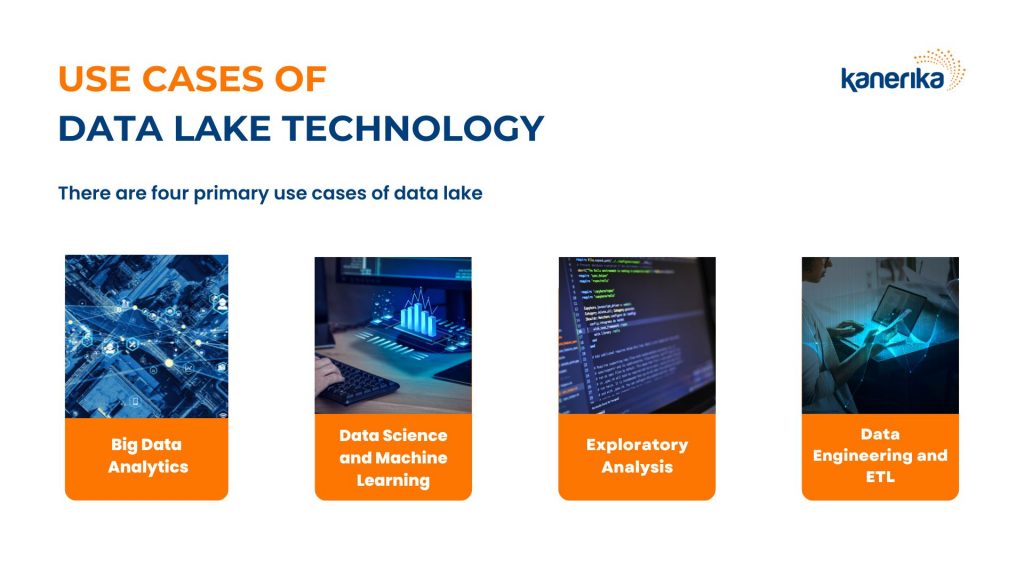“With data collection, ‘the sooner the better’ is always the best answer.” Marissa Mayer’s quote on data is as relevant today as it was a few years ago.
As more businesses and consumers embrace the digital age, the abundance of data drives forward a very important question – what can one do with this data?
Is all data useful, or do just certain kinds of data make more sense to analyze?
The process of filtering through raw data and deriving useful business insights is what data analytics achieves. Most modern data analytics pipelines, therefore, consist of multi-layered steps that each support a useful function.
Data lakes and data warehouses are two such stages in the overall process of data management and data analytics.
But between data lakes vs data warehouses, what’s more important, and how do they each differ in their functionality?
In this article, we look at data lakes vs data warehouses and understand what they are and why they are necessary.
Table of Content
- Data Lake vs Data Warehouse: Understanding the Differences
- Data Lake vs Data Warehouse: Process and Strategy
- Data Lake vs Data Warehouse: Data Type and Structure Used
- Data Lake vs Data Warehouse: Cost, Security and Accessibility
- Data Lake vs Data Warehouse: Use Cases
- Data Lake vs Data Warehouse: Comparison Summary
- Data Lake vs Data Warehouse: Which One is Right for You?
- Kanerika: Your Partner in Data Analytics
- FAQs
Data Lake vs Data Warehouse: Understanding the Differences
Distinguishing between a Data Lake and a Data Warehouse is essential for businesses aiming to make the most of their data. This section describes, in brief, their function.
What is Data Lake?
A data lake is a centralized storage system that can house a vast amount of structured, semi-structured, and unstructured data. It’s designed to store data in its raw format, with no initial processing required.
This allows for various types of analytics, such as big data processing, real-time analytics, and machine learning, to be performed directly on the data within the lake. The architecture of a Data Lake typically includes layers like the Unified Operations Tier, Processing Tier, Distillation Tier, and HDFS.
The primary goal of a Data Lake is to provide a comprehensive view of an organization’s data to data scientists and analysts. This enables them to derive insights and make informed decisions.
It’s a flexible solution that supports the exploration and analysis of large datasets from multiple sources.
What is a Data Warehouse?
A data warehouse is a centralized repository for storing, integrating, and managing structured data from various sources within an organization.
A data lake, which can store both structured and unstructured data in its raw form. On the other hand, a data warehouse is specifically designed for structured data.
Structured data refers to information that adheres to a predefined schema, making it readily understandable and easily queried.
Data Lake vs Data Warehouse: Process and Strategy
Data Lakes are flexible and suited for raw, expansive data exploration, while Data Warehouses are structured and optimized for specific, routine business intelligence tasks.
Both play crucial roles in a comprehensive data strategy, often complementing each other within an organization’s data ecosystem.
Data Lake Process and Strategy
 Data lake tools assist data scientists and analytics with predictive modeling
Data lake tools assist data scientists and analytics with predictive modeling
These are ideal for data scientists and analysts who need to perform in-depth analysis. They need it for predictive modeling and understanding large datasets in their raw form.
- The process begins with ingesting raw data from various sources. These include transactional databases, social media, IoT devices, logs, and more.
- Data ingestion tools like Apache Kafka, Apache NiFi, or custom scripts are used to collect and move data into the data lake.
- Raw data is stored in its native format in a distributed file system, such as Hadoop Distributed File System (HDFS), Amazon S3, or Azure Data Lake Storage (ADLS). No upfront schema is required, allowing for flexibility in storing diverse types of data.
- Data analysts, data scientists, and other stakeholders can use various analytics tools and frameworks to explore and analyze the data in the data lake. These tools include SQL engines, machine learning libraries, and visualization tools.
Data Warehouse Process and Strategy

Business professionals unlock analysis and reporting with data warehouses
Data Warehouses are best suited for business professionals and decision makers. They require operational data in a structured system for analytics and easy querying.
- Data is extracted from multiple operational systems, such as CRM, ERP, and financial systems, using ETL (Extract, Transform, Load) processes. This involves identifying relevant data sources, extracting data using predefined queries or APIs, and moving it to the data warehouse.
- Extracted data undergoes transformation and cleansing processes to ensure consistency, integrity, and quality. Data is standardized, normalized, and aggregated to make it suitable for analysis and reporting.
- Transformed data is loaded into the data warehouse, typically using batch processing techniques. The data is organized into dimensional models, which optimize query performance and facilitate analytical processing.
- Business users, analysts, and decision-makers query the data warehouse using BI (Business Intelligence) tools, SQL queries, or reporting interfaces. They can generate reports, dashboards, and visualizations to gain better insights.

Data Lake vs Data Warehouse: Data Type and Structure Used
Data lakes excel at handling diverse and unstructured data for exploratory analysis and advanced analytics. Meanwhile, data warehouses are optimized for storing and analyzing structured data for operational reporting and business intelligence.
Read More – 6 Core Data Mesh Principle for Seamless Integration
Data Lake Data Type and Structure Used
Data Type: Data Lakes are designed to handle a wide variety of data types, including structured, semi-structured, and unstructured data. This means they can store everything from traditional database records to JSON files and even multimedia files.
Data Structure: Within a Data Lake, data is often stored in its raw form without a predefined schema. It’s organized in a flat architecture where each data element is assigned a unique identifier and tagged with a set of extended metadata tags. When a business question arises, the data can then be transformed and structured to fit the needs of the analysis
Data Warehouse Data Type and Structure Used
Data Type: Data Warehouses primarily store structured data that has been processed and formatted. This data is typically extracted from transactional systems and other relational databases.
Data Structure: Data within a Data Warehouse is highly structured and organized according to a schema-on-write approach. This means that the schema (data model) is defined before the data is written into the warehouse. It’s organized into tables and columns, and data is often aggregated, summarized, and indexed to support efficient querying and reporting.

Data Lake vs Data Warehouse: Cost, Security and Accessibility
While both data lakes and data warehouses are valuable tools for data management, they cater to different needs with distinct implications for cost, security, and accessibility. These are the key differences:
Cost
- Data Lake: Generally offers lower storage costs compared to data warehouses, especially for storing large volumes of raw and unstructured data. Stores data in its raw format, eliminating the need for pre-processing and schema definition, which can be expensive. Additionally, data lakes can efficiently handle large volumes of unstructured data, reducing storage costs compared to structured data warehouses.
- Data Warehouse: Typically involves higher upfront costs for infrastructure setup, licensing, and maintenance, particularly for on-premises deployments. Structured data storage typically requires more processing power, leading to potentially higher computational costs. While data warehouses may have higher storage costs for structured data compared to data lakes, they may offer more predictable pricing.

Security
Accessibility
- Data Lake: More accessible for a wider range of users, particularly data scientists and analysts comfortable working with raw data. They can explore the data without limitations imposed by pre-defined structures. However, some technical expertise might be needed to navigate and analyze the raw data effectively.
- Data Warehouse: Designed for easier access by business users and analysts who may not have extensive technical knowledge. The structured format and predefined queries facilitate faster retrieval of specific data points for reporting and analysis. However, this predefined structure might limit the exploration of unforeseen connections within the data.
Use Cases: Data Lake vs Data Warehouse
Data Lakes offer a more flexible environment suitable for storing and analyzing large volumes of diverse data in their native format, which is beneficial for machine learning, and real-time analytics. On the other hand, Data Warehouses provide a more structured environment optimized for routine, complex querying, and consistent operational reporting.
Data Lake Use Cases

- Big Data Analytics: They are ideal for performing advanced analytics on large volumes of diverse and unstructured data. Use cases include analyzing customer behavior, sentiment analysis on social media data, and uncovering patterns in IoT sensor data.
- Data Science and Machine Learning: Data lakes provide a rich source of raw data for data scientists and machine learning engineers to build predictive models, perform clustering analysis, and conduct feature engineering tasks. Use cases include predictive maintenance, fraud detection, and recommendation systems.
- Exploratory Analysis: Data lakes enable data analysts and researchers to explore and discover insights from raw data without predefined schemas or structures. Use cases include exploratory data analysis, data visualization, and hypothesis testing to uncover hidden patterns and correlations.
- Data Engineering and ETL: Lakes serve as a foundational component for data engineering workflows, allowing organizations to ingest, store, and process data at scale. Use cases include data ingestion from various sources, data transformation pipelines, and real-time stream processing.
Use Cases of Data Warehouses

- Business Intelligence (BI) and Reporting: Warehouses are well-suited for generating standardized reports, dashboards, and KPI metrics for business users and executives. Use cases include sales reporting, financial analysis, and operational performance monitoring.
- Operational Analytics: Data warehouses support ad-hoc and interactive querying for analyzing historical data and identifying trends in operational metrics. Use cases include inventory management, supply chain optimization, and workforce planning.
- Regulatory Compliance and Governance: They provide centralized control and auditing capabilities for ensuring compliance with regulatory requirements, data governance policies, and industry standards. Use cases include GDPR compliance, HIPAA regulations, and internal auditing.
- Data-driven Decision Making: Data warehouses enable stakeholders to make informed decisions based on accurate and consistent data. Use cases include market segmentation analysis, customer segmentation, and churn prediction to drive business strategy and decision-making processes.

Data Lake vs Data Warehouse: Comparison Summary
This table provides a concise comparison of key aspects of Data Lakes and Data Warehouses. It helps to understand their differences and suitability for various applications.
| Aspect |
Data Lake |
Data Warehouse |
| Definition |
A storage repository for raw data in its native format. |
A system for reporting and analysis, storing processed data. |
| Data Types |
Structured, semi-structured, unstructured. |
Primarily structured data. |
| Data Structure |
No predefined schema (schema-on-read). |
Predefined schema (schema-on-write). |
| Cost |
More cost-effective for large volumes of diverse data. |
Higher due to sophisticated hardware/software requirements. |
| Security |
Can be challenging due to the variety/volume of data. |
Generally easier due to structured nature. |
| Accessibility |
Flexible, ideal for data scientists/analysts. |
User-friendly for business users with standard reporting tools. |
| Primary Use Cases |
Big data analytics, machine learning, data discovery. |
Structured business reporting, business intelligence. |
| Data Processing |
Suitable for real-time data processing and analytics. |
Optimized for batch processing and complex queries. |
| Storage Approach |
Cost-effective, scalable for large data volumes. |
Structured, requires data transformation and cleaning. |
| User Skill Level |
Requires more advanced analytical skills. |
More accessible for non-technical users. |
| Maintenance |
Requires robust management to avoid becoming a data swamp. |
Easier to maintain due to structured nature. |
Data Lake vs Data Warehouse: Which One is Right for You?
Choosing between a Data Lake and a Data Warehouse depends heavily on your business needs and intended applications.
Here’s a breakdown to assist you:
Data Lake excels at handling vast quantities of diverse data types, including raw and unstructured data. Its scalability and support for advanced analytics and machine learning make it an attractive option. Considerations:

Data Warehouse specializes in managing structured, processed data, facilitating routine and complex querying with optimized stability and speed in data retrieval and analysis. Considerations:
- If your business heavily relies on consistent, structured data for reporting and business intelligence, a Data Warehouse is ideal.
- Data Warehouses offer quick, dependable data access for operational insights and decision-making processes.
- Opt for a Data Warehouse if your data strategy prioritizes structured data analysis and historical reporting.
Kanerika: Your Partner in Data Analytics
Businesses need more than just data tools to succeed in their data analytics journey.
They need a trusted implementation partner who can help them with strategy and execution. This is where Kanerika shines, with its years of experience and a team of professionals who have worked with multiple industries.
By using the latest data methodologies and advanced tools, Kanerika empowers organizations to transform raw data into actionable insights. The focus? Better data-driven decision-making and business insights.
Embrace the power of data with Kanerika and step into a future with data-driven decisions.

FAQs
[faq-schema id=”27878″]
